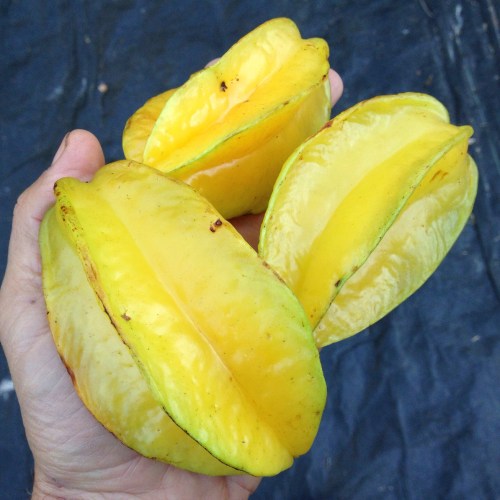
‘Anna’ is an excellent carambola variety, and at the time I write this there are only three trees in the world of this cultivar, two of them in my greenhouse. This variety seems at least as good as the common commercially propagated varieties, and possibly a bit better.
Here’s the story of how it came about.
Back in 2006, I set up my greenhouse and planted it out with fruit trees. One of the trees I set in the ground was a grafted carambola tree of ‘Kari’, a variety that was reported to make good-tasting fruit.
Later that year, I was exploring Pine Island, Florida, with my friend Jose, and we stopped to visit Jose’s friend Anna, who lived on the island. Jose and I arrived at Anna’s house a few minutes before she got there, so we wandered her yard, checking out the plantings of fruit trees.
One tree particularly caught my attention, a carambola tree that was eight feet tall (2.5 meters), and loaded with ripe starfruits that were dropping all over the ground. Jose and I sampled some, and we both agreed that these were fantastic tasting, some of the best starfruits either of us had ever eaten. I figured this must be some good grafted commercial variety Anna had planted. So when Anna arrived, I asked her if she knew the carambola’s variety name. “It’s a seedling,” she said. “I planted a seed.”
Here was a tree making some of the best carambolas I’d ever eaten, and… it was the only one of its kind in the world. With Anna’s permission, I clipped a few twigs of budwood from this tree for grafting, and took them back with me to North Florida.

I grafted a twig from Anna’s tree onto a side branch of the ‘Kari’ carambola tree that was already growing in my greenhouse, and the graft thrived. I like to name fruit tree varieties after either the place they came from, or the person who originally planted them, so in this case it seemed appropriate to call the new variety ‘Anna’. Over the years, I selectively pruned the tree to maintain both the ‘Anna’ and ‘Kari’ parts, but when both made fruit, ‘Anna’ carambolas clearly had better flavor, so I pruned to allow the ‘Anna’ portion of the tree to get larger than the ‘Kari’ part.
I’ve since grafted ‘Anna’ onto two seedlings, once of which I planted in another spot in the same greenhouse, and the other I gave to Josh Jamison at the Heart Institute in Lake Wales, Florida, to trial there in the central part of the peninsula. And I heard a report from Anna that the original tree on Pine Island has died. So these three trees are the only ones there are of this type, unless someone else propagated from Anna’s tree.
My conditions aren’t really ideal for carambola growing – I take the plastic off the roof of the greenhouse every spring, and over summer the carambola trees frequently grow right through the metal frame of the greenhouse roof, then in fall I have to whack the trees back heavily to get the plastic back on. And sometimes the greenhouse temperature dips slightly below freezing in winter, and the carambola trees partially defoliate. Both the heavy pruning and the cold temperatures are bad for quality and quantity of fruit production.
So I can’t really say for sure how this variety compares to other carambola varieties – all I can say is that under my conditions, the ‘Anna’ fruits generally taste better than the ‘Kari’ fruits growing on the same multi-grafted tree. The trees tend to have several flushes of fruit per year, and flavor seems sweetest and richest when the fruits ripen during warm weather, when there aren’t too many fruits on the tree. Cool weather or extremely heavy fruit set both seem to result in less intensely flavored fruit.

I want to propagate more trees of this variety so I can distribute them to people in more favorable carambola-growing areas in Central and South Florida, to better evaluate this type alongside other carambola varieties.
One interesting note: I’ve been hearing the last couple of years about a new carambola variety that’s supposed to have excellent fruit, called ‘Red’s Dumpster’ because the original tree grew outside Red’s seafood restaurant on Pine Island, near the dumpster. At least one nursery propagating that variety has given it the new, more marketable name, “Pine Island Gold’. I haven’t tasted ‘Red’s Dumpster’ carambola, but I recently saw photos of the fruit, and they look exactly like the fruits of ‘Anna’ carambola. Since both varieties come from Pine Island, it’s entirely possible that they could be siblings, or one could be a seedling of the other.
One thought on “I named this carambola variety ‘Anna’”